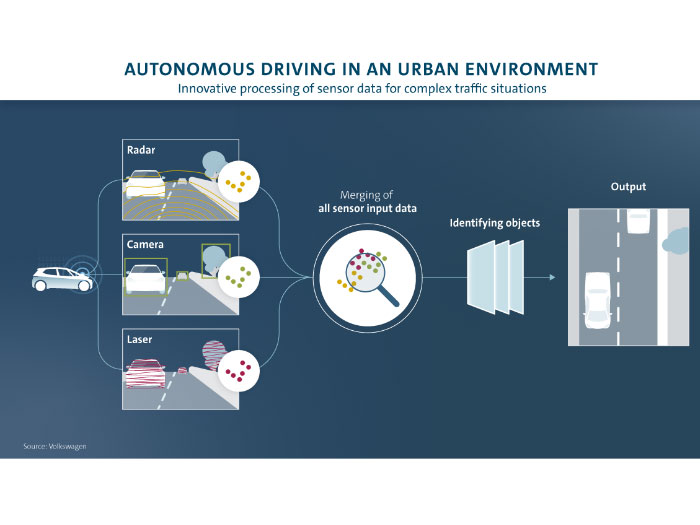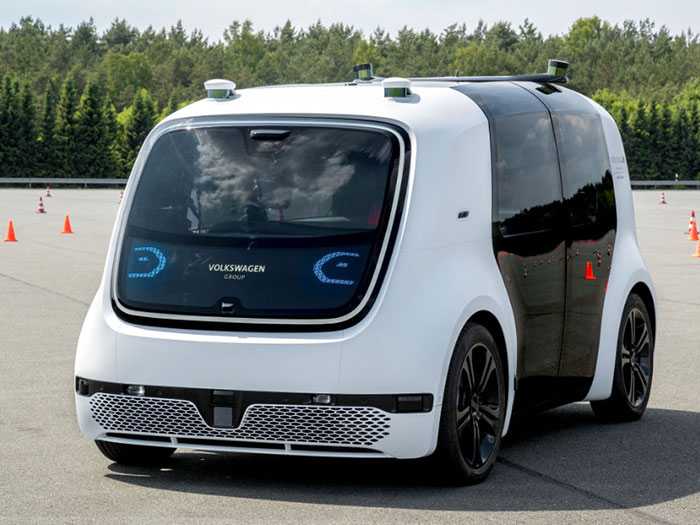Autonomous driving in the city: the hardest challenge
Urban traffic is the most complex context for a self-driving car. Volkswagen is developing solutions that combine efficiency with the highest levels of safety, and has joined forces with IBM and universities from different countries.
A number of Advanced Driver Assistance Systems (ADAS for short) have been available on Volkswagen Group cars for many years already, including Lane Assist and Adaptive Cruise Control (ACC). Although these systems help drivers and ensure greater safety, they only operate when driving on motorways and main roads.
In urban traffic, however, automated driving functions are a completely different challenge. In order to overcome the hurdles, Volkswagen has joined forces with IBM, the Technical Universities of Cluj-Napoca, Prague, and ETH Zurich within the 'UP-Drive' project funded by the European Commission.
The UP-Drive project
The name ‘UP-Drive’ stands for Automated Urban Parking and Driving; the project aims to make autonomous driving a reality in cities throughout the world by accelerating the development of the technology - especially when it comes to artificial intelligence and robotics.
“Public support for these kind of research projects is a good investment because it has the potential to showcase the ability of European academic and industrial researchers to bring real benefits to our citizens,” said Mariya Gabriel, EU Commissioner for the Digital Economy and Society.
The greatest challenge
“The peculiar thing about this project is that it takes place in urban areas with extremely different traffic situations, and the infrastructure is also different in every city,” explains Axel Heinrich, Head of Volkswagen Group Innovation.
The long-term aim of Volkswagen and its project partners is to use autonomous driving functions not only on the motorway and when parking, but also in traffic. “Urban traffic is the greatest challenge for autonomous driving. If you can handle this, you can handle the entire spectrum,” emphasises Heinrich.
The key role of sensors...

There is still a long way to go, and a lot of basic research to be done. For example, in the field of sensor technology. Any autonomous vehicle requires various sensor systems: laser, radar and cameras, for example, scan the environment for possible hazards. Each of these sensors evaluates its own input data and extracts relevant objects. These objects are then compared using artificial intelligence and connected to each other. This works well on the motorway, but in much more complex urban traffic the approach soon reaches its limits.
...processors...
UP-Drive research partners have therefore developed and implemented a new idea. Instead of processing sensor data separately, all raw sensor data are now first sent to a central processor where they are correlated with each other. Only then are relevant objects extracted. In other words, no data that could be relevant for the final picture is lost between the transfer from the sensor to the central processor – for example, the exact position of a pedestrian in a fraction of a second.
Precision is what counts. For this reason, the calibration of the sensors in the vehicle is absolutely crucial and must be 100% correct at all times. It must not be impaired, for example, by a stone chip or thermal changes.
...and calibration
For this reason, the system performs the calibration “online”, i.e. constantly during operation. If it detects a deviation, the system reacts within a few 100 milliseconds and compensates for errors. The innovative thing about this is that the data from different sensors will be cleverly compared. As a result, significantly higher precision is achieved and the car remains fully functional at all times. This technology could soon be incorporated into the production of new models.
Mission Autonomous Driving

The “Mission Autonomous Driving” project was launched by the Volkswagen Group at the beginning of the 2000s in the USA. As part of the DARPA Grand Challenge, launched by the Defense Advanced Research Projects Agency (an agency of the US Department of Defense responsible for developing emerging technologies for use by the military), a Volkswagen drove autonomously through the Mojave Desert in Nevada. This was followed in 2007 by the first attempts to test autonomous driving in urban areas. In 2017, SEDRIC, short for SElf-DRIving Car, was presented for the first time as a concept vehicle. It showed how an autonomous vehicle might look in the future. Namely: available at the push of a button, simple, sustainable, comfortable and safe.
Today, most driving tasks in traffic are still performed by the driver, but gradually the responsibility will be transferred to the vehicle. This means that systems will perform certain driving tasks independently and without human intervention – initially for a limited period of time and under suitable, predefined conditions. The joint research work in the ‘UP-Drive’ project has a major role to play in ensuring that this development continues and that driving becomes increasingly safer.
Source: Volkswagen AG
